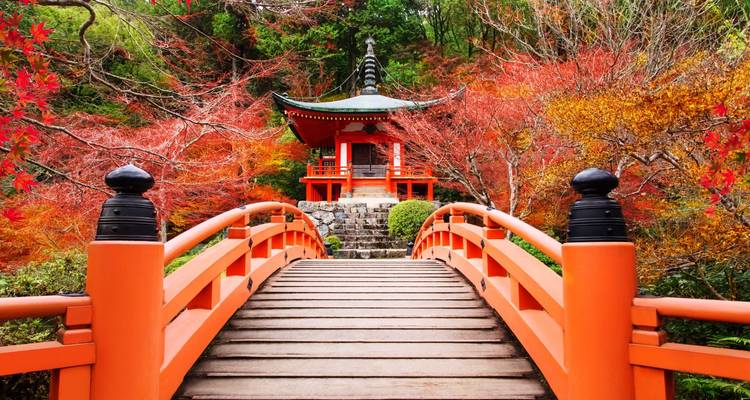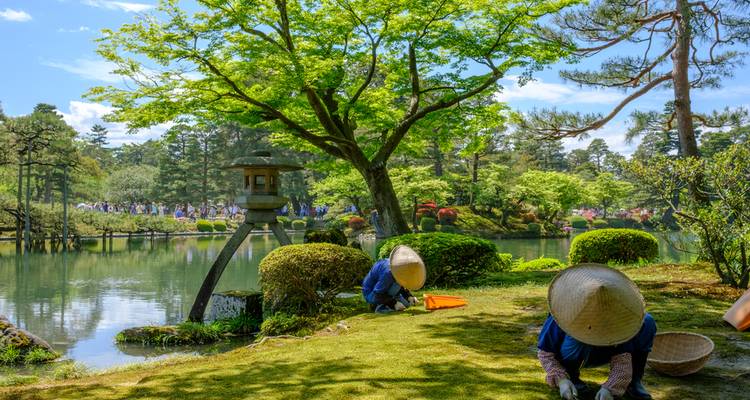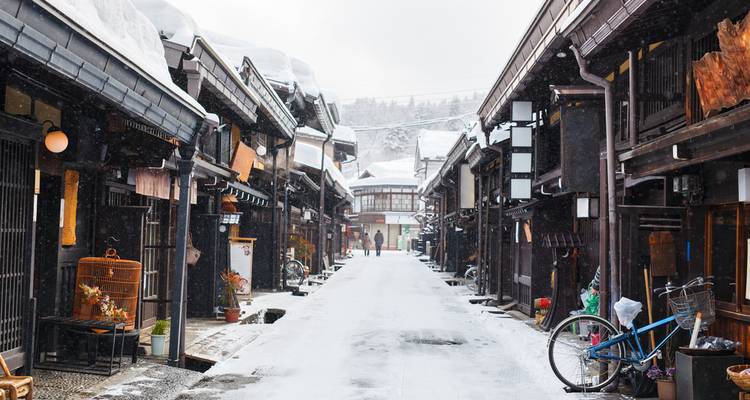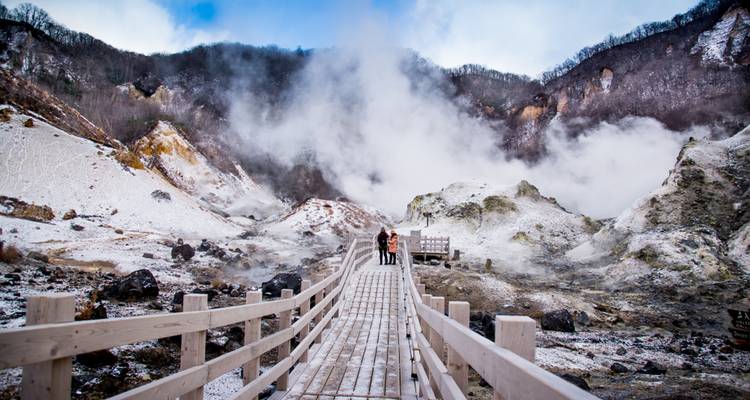Itinerary
- Day 1
Tokyo
You'll land and clear customs, then take a shared shuttle bus to your hotel. After that, the day is yours to rest and get settled in. In the afternoon you'll receive all the tour details and information you need for the coming days.
- Accommodation
- Hotel (Shinagawa Prince Hotel)
- Day 2
Tokyo
Start the morning with a five-hour guided tour through Tokyo's neighborhoods. You'll see Zojoji Temple with Tokyo Tower views, cross the famous Shibuya Crossing, check out Meiji Shrine and Omotesando Avenue, walk through Imperial Palace gardens, and see Nijubashi Bridge. From there, head to Akihabara to explore the anime culture scene, then take the elevator up Tokyo Skytree for city views from high above. Later in the day, get to Asakusa and walk through Sensoji Temple and the Nakamise shopping street. In the evening, take the subway to Shinjuku, wander around the lively district, grab dinner at a local spot, and head back to your hotel.
- Meals
- Dinner (Dinner at local restaurant in Shinjuku area)
- Accommodation
- Hotel (Shinagawa Prince Hotel)
Included Activities
- Guided tour of Tokyo (approximately five hours)
- Visit Zojoji Temple
- Visit Shibuya Crossing
- Visit Meiji Shrine
- Tour along Omotesando Avenue
- Explore Imperial Palace and gardens
- Visit Nijubashi Bridge
- Visit Akihabara
- Tokyo Skytree admission and panoramic view
- Visit Sensoji Temple
- Explore Nakamise Street
- Subway tour of Shinjuku area
- Dinner at local restaurant
Landmarks/POIs Zojoji Temple Tokyo Tower Shibuya Crossing Meiji Shrine Omotesando Avenue Imperial Palace Nijubashi Bridge Akihabara Tokyo Skytree Sensoji Temple Nakamise Street Shinjuku - Day 3
Tokyo to Hiroshima
After breakfast, board the bullet train to Hiroshima (about four hours, covering 800 kilometers). Once there, you'll walk through Peace Memorial Park, see the Atomic Bomb Dome, and spend time in the Peace Memorial Museum. After that, take a ferry out to Itsukushima, also called Miyajima Island, to visit the shrine that's partially built over the water. You'll have time to explore the shrine grounds and wander through the island's center before lunch. Then head back to Hiroshima for the evening and dinner.
- Meals
- Breakfast, Dinner
- Accommodation
- Hotel (Candeo Hatchobori), Hotel (Hilton Hiroshima)
Included Activities
- Bullet train to Hiroshima
- Visit Peace Memorial Park
- Visit Atomic Bomb Dome
- Visit Peace Memorial Museum
- Ferry to Itsukushima Shrine
- Visit Itsukushima Shrine
- Explore island center
Landmarks/POIs Peace Memorial Park Atomic Bomb Dome Peace Memorial Museum Itsukushima Shrine - Day 4
Hiroshima to Matsuyama
Take a ferry to Shikoku Island (roughly two and a half hours) to see more of Japan's island landscape. In Matsuyama, ride the cable car up to visit the impressive castle, then continue to Ishiteji, a beautiful Buddhist temple and pilgrimage site. Have lunch at a local restaurant. Spend your afternoon at Dogo Onsen, a traditional Japanese bathhouse from the 19th century, where you can soak and relax.
- Meals
- Lunch (Lunch at local restaurant)
- Accommodation
- Hotel (Ana Crowne Plaza Matsuyama)
Included Activities
- Ferry to Shikoku Island
- Cable car ride to Matsuyama Castle
- Visit Matsuyama Castle
- Visit Ishiteji Temple
- Admission to Dogo Onsen
Landmarks/POIs Matsuyama Castle Ishiteji Temple Dogo Onsen - Day 5
Matsuyama to Kobe
Head to Kotohira and climb 785 steps up Mount Zosu to reach a Shinto shrine dedicated to the God of sailors. Then travel to Takamatsu and visit Ritsurin, one of Japan's most beautiful gardens with carefully arranged landscape. After lunch at a local restaurant, go to Naruto to see an impressive bridge spanning the sea with a glass floor section that lets you look down at the powerful sea whirlpools from 45 meters up. Cross several scenic bridges connecting the islands before arriving in Kobe for the night.
- Meals
- Lunch (Lunch at local restaurant)
- Accommodation
- Hotel (Kobe Meriken Park Oriental Hotel)
Included Activities
- Visit Kotohira Shinto shrine
- Visit Ritsurin Garden
- Visit Naruto Bridge
- Walk along Naruto Bridge glass floor
Landmarks/POIs Kotohira Shrine Ritsurin Garden Naruto Bridge - Day 6
Kobe to Mount Koya
Start in Kobe visiting the Earthquake Memorial Museum, which honors the 1995 earthquake and shows how the city rebuilt itself. Then continue on to Mount Koya, the most important center of Shingon Buddhism with 120 temples and monasteries spread across the area. You'll visit the Okuno Mausoleum, a spiritual cemetery in nature with over 200,000 graves, and see Kongobuji Temple, built in 1593. Tonight you'll stay in a Buddhist monastery where monks lead Zen meditation practice called Ajikan. Vegetarian dinner is included, and if you're interested, you can attend the temple's religious ceremony before breakfast the next morning.
- Meals
- Dinner (Traditional vegetarian meal at monastery)
- Accommodation
- Hotel (Monasterio Hojoin)
Included Activities
- Visit Earthquake Memorial Museum in Kobe
- Visit Okuno Mausoleum
- Visit Kongobuji Temple
- Zen meditation practice (Ajikan) at monastery
- Overnight stay at Buddhist monastery
Optional Activities
- Attend religious ceremony at temple before breakfast
Landmarks/POIs Earthquake Memorial Museum Okuno Mausoleum Kongobuji Temple - Day 7
Mount Koya to Kyoto
Start with a traditional Japanese breakfast at the temple. Then leave early for Kyoto, Japan's former capital that ruled from 794 to 1868 and housed the Imperial Court. The city largely escaped bombing during World War II, so it keeps extraordinary artistic and cultural heritage throughout. Visit the magnificent Fushimi Inari Shinto Shrine, explore the historic Imperial Palace, and see Kinkaku-ji Temple (the Golden Pavilion) with its beautiful gardens. You'll have free time to wander around, then head to Gion, the traditional district known for geisha culture, where you can spend time soaking in the unique atmosphere.
- Meals
- Breakfast (Traditional Japanese breakfast at temple)
- Accommodation
- Hotel (New Miyako Hotel)
Included Activities
- Traditional Japanese breakfast at temple
- Visit Shrine of Fushimi Inari
- Visit Imperial Palace
- Visit Kinkaku-ji Temple (Golden Pavilion)
- Explore Gion district
Landmarks/POIs Shrine of Fushimi Inari Imperial Palace Kinkaku-ji Temple Gion - Day 8
Kyoto to Kanazawa
After breakfast, drive along one of Japan's largest lakes and stop at Shirahige Ginra, a small shrine right by the water. Continue to Eihei-ji, a temple-monastery founded in 1244 and a key hub of Zen Buddhism (admission included), which features serene surroundings, interesting architecture, and gardens. In Katsuyama, check out the Dinosaur Museum at Japan's largest dinosaur fossil site with over 40 dinosaur skeletons on display, then see the Great Buddha of Echizen and its grand temple with a five-story pagoda you can climb for views of the surrounding area. You'll arrive in Kanazawa by evening.
- Meals
- Breakfast
Included Activities
- Visit Shirahige Ginra Shrine
- Visit Eihei-ji Temple-monastery
- Visit Dinosaur Museum
- Visit Great Buddha of Echizen
- Visit Echizen five-story pagoda
- Climb five-story pagoda for panoramic views
Landmarks/POIs Shirahige Ginra Shrine Eihei-ji Temple Dinosaur Museum Great Buddha of Echizen Echizen five-story pagoda - Day 9
Kanazawa
Spend the full day in Kanazawa, a city that once competed with Kyoto and Tokyo and also escaped World War II bombing. Begin with a guided city tour to see the impressive castle area and its walls, then stroll through Nagamachi, the historic neighborhood where samurai families once lived, with preserved residences, earthen walls, gates, and water canals still visible. Visit Kenrokuen, one of Japan's three most beautiful gardens (admission included). End at Omicho, a lively traditional market where you can pick from many lunch options. The afternoon is free for more exploring on your own.
- Meals
- Breakfast
Included Activities
- Guided city tour of Kanazawa
- Visit Kanazawa Castle area
- Explore Nagamachi neighborhood
- Visit Kenrokuen Garden
Landmarks/POIs Kanazawa Castle Nagamachi neighborhood Kenrokuen Garden Omicho Market - Day 10
Kanazawa to Takayama
Travel through beautiful mountain landscapes, forests, and traditional villages in the UNESCO World Heritage areas of Gokayama and Shirakawago. These villages feature traditional houses with steeply sloped roofs that look like praying hands, designed to handle heavy winter snow. Stop in Ainokura, a charming small village, then Shirakawa-go Ogimachi, a larger village where you can stroll around and enjoy lunch. Next, go to Takayama and visit the Hida Folk Village Museum, an open-air museum with over 30 traditional houses from the Edo Period (1603-1868) showing historical tools and daily items. You'll have free time to walk through the old town with its wooden houses and traditional shops.
- Meals
- Breakfast
Included Activities
- Visit Ainokura village
- Visit Shirakawa-go Ogimachi village
- Visit Hida Folk Village Museum
Landmarks/POIs Ainokura Shirakawa-go Ogimachi Hida Folk Village Museum - Day 11
Takayama to Nagano
After breakfast, head to Hida Furukawa and stroll through the charming old town. Visit a museum showcasing the city's UNESCO-declared Intangible Cultural Heritage festival with its large drums and beautifully decorated floats. Then cross through the renowned Japanese Alps with their snow-covered peaks and dramatic scenery. When you reach Matsumoto, visit the impressive castle known as the 'Crow Castle' because of its black color, dating back to the 16th century. You'll have free time to grab lunch and explore the town. In the afternoon, head to Nagano for your accommodation.
- Meals
- Breakfast
- Accommodation
- Hotel (Metropolitan Nagano)
Included Activities
- Stroll through Hida Furukawa old town
- Visit Hida Furukawa festival museum
- Visit Matsumoto Castle
Landmarks/POIs Hida Furukawa Matsumoto Castle - Day 12
Nagano to Ikaho
In Nagano, visit Zenko-ji Temple, a famous pilgrimage site that houses Japan's first Buddhist image. Participate in the Gomakuyo ceremony, a traditional ritual meant to bring good fortune. Then head into the beautiful Japanese Alps and travel through majestic mountain scenery to reach Jigokudani Monkey Park. Walk through forested trails, past rivers and hot springs where Japanese macaques live and bathe in the warm water. Continue through high-mountain landscapes (reaching 2,172 meters or 7,126 feet) and pass by semi-active volcanoes. Stop in Kusatsu, a charming hot-spring town, to stroll through the city park with its open-air onsen and enjoy free time for lunch. Arrive in Ikaho, another charming hot-spring town, and stroll through its old center famous for traditional stone stairways. Stay overnight in a traditional ryokan where you can enjoy hot-spring baths. Traditional Japanese dinner is included.
- Meals
- Breakfast, Dinner (Traditional Japanese dinner)
- Accommodation
- Hotel (Hotel Moriaki Ryokan)
Included Activities
- Visit Zenko-ji Temple
- Participate in Gomakuyo ceremony
- Walk through Jigokudani Monkey Park
- Stroll through Kusatsu city park
- Explore Kusatsu open-air onsen
- Stroll through Ikaho old center with stone stairways
- Stay at Ryokan with hot-spring bath access
Landmarks/POIs Zenko-ji Temple Jigokudani Monkey Park Kusatsu Ikaho - Day 13
Ikaho to Tokyo
Continue to Nikko, a fantastic town where you'll visit the impressive Nikko-Toshogu Temple known for its famous room with the sound of a dragon echoing inside. Explore the Taiyuinbyo Mausoleum, a serene and inspiring site set in nature. Take a walk along Kanmangafuchi Abyss, where hundreds of Jizo statues silently watch over the riverbanks below. You'll have free time to explore the town center before heading back to Tokyo, arriving around 6:30 p.m.
- Meals
- Breakfast
- Accommodation
- Hotel (Shinagawa Prince Hotel)
Included Activities
- Visit Nikko-Toshogu Temple
- Visit Taiyuinbyo Mausoleum
- Stroll along Kanmangafuchi Abyss
Landmarks/POIs Nikko-Toshogu Temple Taiyuinbyo Mausoleum Kanmangafuchi Abyss - Day 14
Tokyo
After breakfast, your journey through Japan comes to an end. You'll leave with plenty of memories from the past two weeks exploring temples, mountains, gardens, and the unique culture of different regions.
- Meals
- Breakfast











